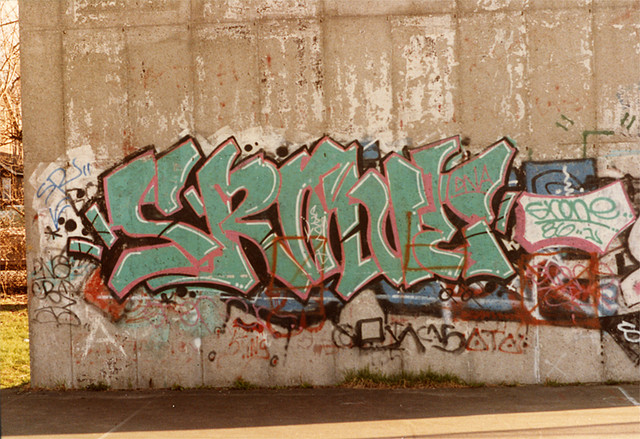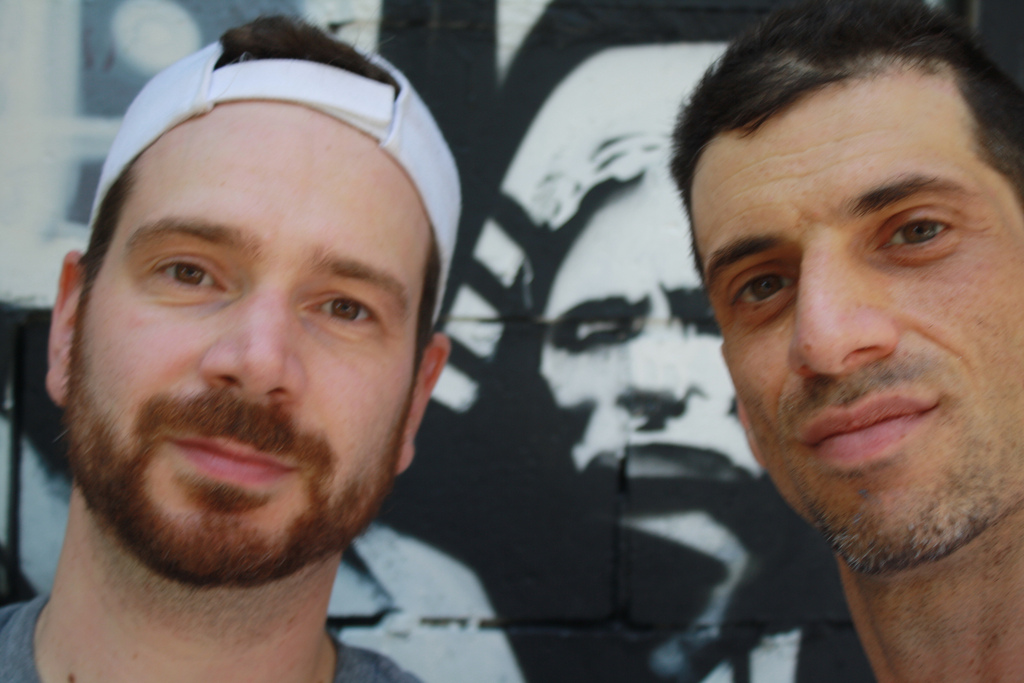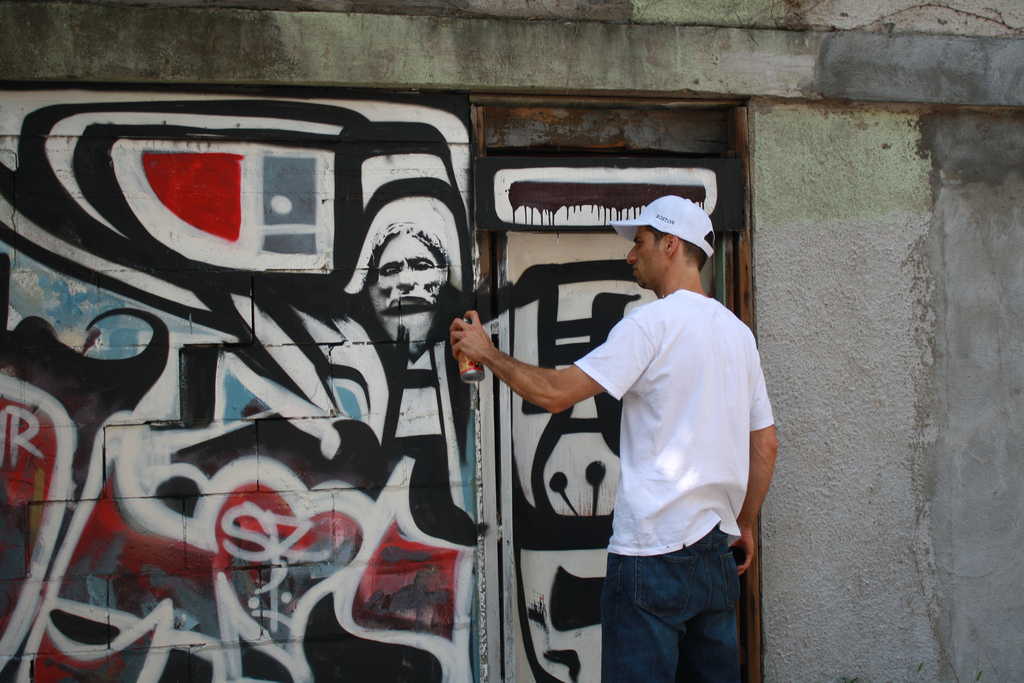Take a look at the interview he conducted after the jump…
Escaping the Game
Interview with 1980’s Graffiti Legend SR-1 (pronounced “sir-own”),
Founder and President of THR Crew
By Dan Plasma
As we we sit parked by Little Stevie’s House of Pizza, a Boston landmark, I blatantly stare with admiration at a woman walking past us in a beautiful skin tight, light material, yoga pant. “That’s disgusting” SR-1 says “I hope my daughter never dresses like that.”
“Oh yeah” I say, quickly turning my head, “Oh yeah.”
I first chilled with SR-1 about fifteen years ago when the writing scene was more alive and less commercial. Josh (SRONE’s real name), founded THR crew,(“The Human Race”) the same year that AMPM (“All Mighty Psychedelic Mutherfuckers”), my crew, was founded, so we connected with a lot of history, and a deep passion for art with meaning. If there was ever an artist with impressive skills to whom spiritual and ethical creative content was an obsession, it would be SR-1. SRone doesn’t care about making art with spiritual meaning, he obsesses over it. I’ve actually been annoyed at him while painting, having him basically berate me for painting pretty pictures with no meaning, only to later do more political or meaningful work once I realized that his annoying obsession for spirituality and meaning was somewhat valid.
When painting two recent murals with SR1, and catching up with old times, he wouldn’t stop talking about a vegan diet, the Torah, and KRS 1. He is one of the most intelligent people I’ve ever met. It’s refreshingly rare to meet someone on that genuinely scholarly level who is so leftist. I still get about two emails a week from him with links to ancient vegan gladiator diets, although I’m more hungry for old stories from back in the day about other 80’s Boston graffiti legends like Mass, Click, Hang, Remote and Detect.
Somehow, Sr-1’s phone number got around back then and other writers extended the respectful classic Boston invitation to steal cars and go bombing. Everyone falsely assumed because of his hard style and how he got up that SR-1 was a gangster, but the exact opposite was true of Josh. I believe that Mass is in jail again for robbing banks, I have no idea what the other 80’s Boston writers are up to except for a few. SR-1, however, is a successful designer and devoted and loving father.
SR1 is part of a very early generation of graffiti writers from Boston, one of the most important individuals in street art from that primitive 1980’s era. Although the technology was far more cancerous and deadly, and the art far more primitive, the personal connections we made back then and what it all meant seems deeper and more genuine than what graf is about today. I think we both used graf to escape, and to find truth…
Plasma: What are your first memories of graf?
SR-1: Manhattan street and truck graffiti. Writers such as Proph (Prophet), Reveal, Shadi, Jonas, Sash, Dash, Revlon, Quick, Dek5. Tess X-men, Mac, Dust, Mirage, amazing tags and handstyles around Canal St. and West 4th St. Of course I was really inspired by, Ahern’s Wild Style, Style Wars and Henry Chalfant’s Subway Art. They painted the Orson Wells theater in Cambridge for the opening of Wild Style (I think it was Lady Pink who did it – I don’t remember).
My uncle has been a photographer in Manhattan since the early 1980’s and whenever I would visit him or relatives in Queens or out on the Island, I would be in awe of all of the layers of fresh well-practiced throw-ups around town. NY was the place of the graffiti renaissance and I was very influenced as a witness to some of it.
Plasma: Who were the most skilled writers back then?
SR-1: As for skilled Boston writers, I would say the following were active and had nice styles: Click, Kon, Hang, Remote, Tale, Mass, Mkay, Def, and Drone. There were also a couple of prolific writers around the Cambridge area :Yogurt and HOOT. HOOT used to really bomb with outlines everywhere like no one else at the time (1984) and Yogurt had an amazing flowing tagging handstyle and I was told he could do it equally as well writing backward such as on the inside of a glass window. Having talked to people and from seeing a Yogurt CIA tag on a truck in the Flower District in Manhattan – I am pretty sure he had affiliations with NY writers such as Zephyr and others.
Plasma: What was the technology like back then?
SR-1: As far as markers go we had: Magnums, Sno man, Pilot, Pilot Ink, Uni (Japanese 2” wide calligraphy markers and ink by Holbein) from EJ Ardon’s down near Fenway Park, Marsh Ink, Sakura .5” wide metallic markers. When I was first starting out I tagged with Magnum 44 markers but it turned brown and faded and the nibs I found not to be as good as say Pilot ultra wides. Soon, I would mainly use Pilot ultra wide markers flooded with Pilot ink as well as my own hand made wide mops made from nice school blackboard erasers. These I would flood with mixtures of black and dark blue (Prussian Blue) creating what I would learn to be called “rich black.” When I met SABE he told me of the purple supermarket ink (aka Garvey) and when I met RELAX he told me where to get the Marsh
ink in Brooklyn.
As far as paint spray caps – at this time fat caps were not sold like nowadays. My all purpose caps were gotten from Testor’s model spray paint and varnish. From RELAX, I learned of amazing fat caps from Afta non-slip carpet spray and also I would get them from industrial spray cleaners at high school. The paint I mainly used was Krylon. At that time, my writing partner SEV2 and I were inspired by clover green, jungle green, banner red, brick and basic white and semi-flat black colors.
Plasma: Your skill set with piece letters was always considered top notch, who were some early mentors for you?
SR-1: Aside from studying the Queens highway walls, my main style mentor was Relax (affiliated with CWK, AOK, BYI and other crews) of Brooklyn who well was connected with the whole 1980’s graffiti scene. A couple of years previous to him I met Sabe of Staten Island who had some fresh styles, and was perhaps influenced by Erni New Wave.
Plasma: When and why did you form THR, and what does it stand for?
SR-1: I started THR (The Human Race) crew back in 1988 as a kind of play on the TMR (The Master Race) moniker. THR was like kind of utopian in it’s inception – by all the people and for all the people. It was a kind of world clique idea like Deee-Lite or something.
Plasma: Was TMR some skinhead graf like Zhar Zhay or just an incredibly politically incorrect choice for a crew name?
SR-1: I didn’t know much about TMR crew; just that what it stood for was kind of over the top and I had seen it up. Also, I had a sense of the whole vibe from my cousin Pete who grew up in Queens. I recall it was like in the newspapers for some reason at that time. Though the original THR moniker stood for The Human Race, now I prefer to have it stand for The Heart Revealed.
Plasma: Were there members of TMR who were not of the so called “master race”?
SR-1: Yes, TMR contained Hispanic members, Jewish members, Italians; TMR was not an Aryan gang, just a poorly named graffiti crew.
Plasma: When did Barry (“Twist”) come aboard and join THR?
SR-1: Circa 1989 I mentioned to Twist the THR crew thing and at some point after that he was writing it. I actually used to write SOEL around the SF metro area (mostly south of Market and I the Mission)and TWIST and I would write together sometimes. At that time, I became roommates with him near Haight Ashbury in San Francisco and I remember being out of town and coming back to find he had raided my red Marsh ink stash and had bombed around the neighborhood with fat drippy mop tags – the rest is history…
Plasma: When you and I chilled almost 15 years ago you were expanding into other creative fields, such as video editing, does the graf still come up?
SR-1: Yes, I see a lot of parallels between the so called style wars aspect of graffiti as seen in Style Wars the documentary and the graphic design world today. People are competing to create the freshest designs getting influenced by other designers around for better or for worse. There are experienced style mentors to learn from and often established styles and guidelines to adhere to and then to take one step beyond. For example, I designed an arrow as an ad element for my boss and was told that it was a good idea. In addition to appreciating the success, I couldn’t help but think that they should watch Style Wars to hear the film quote saying how “everyone has their own style arrow”.
Plasma: Street art has been deeply popularized and legitimized since the 80’s. It seems like all the writers back then had amazing skills, with tagging AND piecing. If you weren’t an amazing and original artist you got no respect, you were laughed at and called a “toy”. Back then the artform, and real badass skills, seemed to get more respect proportionally than putting in tag work. All of the crews communicated with each other, back then, it was more about squashing beef, maintaining real work, and preventing toys from dissing. how do you feel about the dramatic changes in the movement?
SR-1: Back in those days we didn’t have the internet and it’s mass media entities copying/stealing youth counter culture and selling it back pre-packaged as a kind of style template. Kids used to go out and make things happen and create things hands on – more collectively. That’s just what people did. To play video games, home boys (so to speak) would go to the game arcade to play the freshest games from Japan. There was a merging/cross-pollination you rubbed shoulders with kids from cultures across all economic & cultural boundaries. The whole street art/graffiti thing for me was an outlet for energy, creativity, fun and innovation in the streets. After “the Buff”, NY train graffiti spilled out onto the streets/highways and the world. People like Keith Haring and Jean Michel Basquiat broadened the perspectives of people as to what street art could be and eventually gave birth to people like Barry McGee and Shepard Fairey today. I think there is always a place for tagging as a very primal basic thing for all people – like seeing a 2.5 year old wanting to doodle and express. But, there is a hierarchy in order of importance: Pieces then Throw-ups, then outlines, then tags. Those people who are multi dimensional and do all of them well perhaps could be considered a “good” graffiti writer. A tag or throwup is more disposable and temporary and though they can be beautiful, it still ain’t a piece.
Plasma: The many dimensions of your current creative work expand to express your passionate views on life, you seem to let everything in life just come to you without stressing about it, why is creating art with spiritual meaning so crucial to you?
SR-1: I think about what are we marketing, what are we conveying to folks – young and old. America is a relatively free country so to speak and the artist can express whatever they want to – and that is a beautiful thing. But, I believe what a teacher once told me (Al Blaustein – RIP a Cooper Union alumni who him elf was part of a visual art movement in NYC during the 1950’s-60’s) – “It is the artist’s responsibility to enrich and contribute to the society in an ethical way”
Plasma: You seem super busy with your daughter, what will you tell her when she asks about tagging and if its right or wrong? Are you planning on passing on your mastery and appreciation for graffiti to her?
SR-1: The whole tagging/graffiti phenomenon, a small part of the beautiful renaissance, which I caught the end of in the 1980’s was part of a unique time and place. I plan to teach my daughter the historical context of why this artform emerged and what I witnessed. Hip hop and graffiti originally was a way for people to escape New York City’s slide into darkness due to Robert Moses’ failed urban renewal projects of the 1970’s. Moses’ projects ripped the economic heart, human soul and many many families out of neighborhoods across the city. Graffiti/hip hop, was a creative, expressive tool, for hope and change at that time. The visual part of the art form reaches us through the eyes which are said to be a window to the soul.







